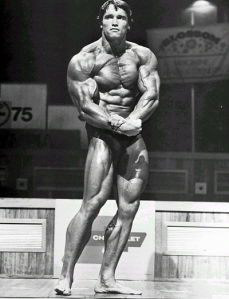you’ve come a long way, baby… sort of…
“There is a Princess in every girl. To be a Princess is to always look your best.” – Barbie
According to the US CDC, the average 19 year old American female is 62.7 inches tall, weighs 138 lbs, has a 32 inch waist and a head circumference of 20 inches. By comparison, (at a 1:16 ratio), a “life-sized” Barbie would be 69 inches tall, weigh 110 lbs, have an 18 inch waist and a head circumference of 22 inches.
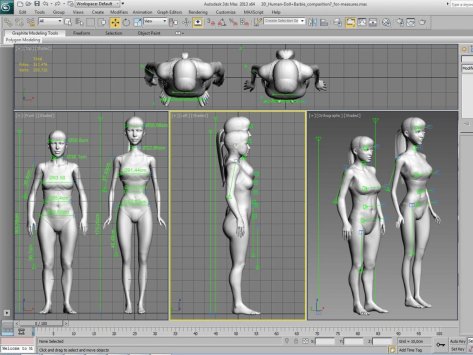
Recently, artist and University of Pittsburgh alumni, Nickolay Lamm, created a model of Barbie re-imagined as a “real” woman. © Nickolay Lamm, mydeals.com, http://www.mydeals.com/blog/what-if-barbie-looked-like-a-real-woman/post
Besides the gargantuan head, Barbie sports feet reminiscent of Tang Dynasty Imperial China, arms fashioned after an anorexic spider, and a neck that looks like an early prototype for the giraffe.
In fact, to actually attain Barbie’s mythic proportions, the average 19 year old female would need to gain over 6 inches in height and surgically remove her bottom ribs, her trapezii, half of her triceps, most of her forearms, her hamstrings, her calves, plus her glutei maximi. She would also need an ear reduction, a brow lift, a jaw line shave, a nose job, a neck reduction, a breast augmentation and a tummy tuck.
While fans laud the doll as a female-centered creative outlet for young girls , empirical research confirms that Barbie’s buxom proportions are not only unhealthy, they are biologically and statistically unattainable, with fewer than 1 in 100,000 women likely to be blessed cursed with her peculiar weight distribution (Ken’s physique, on the other hand, is a relatively common 1 in 50). But still they try, which is, perhaps, the point, because western females begin to internalize the cliché that “nothing tastes as good as skinny feels,” around the age of six, and research has consistently correlated Barbie with increased body dissatisfaction and eating disorders in young girls.
Whichever side of the debate you land on, however, there is little doubt that Barbie’s unrealistic and idealistic proportions epitomize men’s neurobiological evolutionary preference for low waist-to-hip ratio, smooth hairless skin, big eyes, pre-Raphaelite hair, and large pronounced breasts, all of which are signs of reproductive viability.
As do Maxim models.
As do Playboy Bunnies.
Mass media and iconic status are potent envoys of sociocultural ideals and in this sense, the power of Barbie far outweighs the impact of Maxim or Playboy because she is the stuff of legend, an iconoclastic ideal that undergirds our very concept of feminity—in the so-called First World, at least—through a never ending stream of movies, books, toys, housewares, clothing and costumes.
Well, that plus the fact that we market her to five year olds…
And this only makes the latest addition to Barbie’s Dolls of the World Series all the more discombobulating because when gender controversy collides with harassment scandal, it creates the Perfect Storm:
Ladies and Gentlemen, all the way from Canada, wearing “the ancestral clothing of her country,” put your hands together for RCMP Barbie...
What’s next? Sexual Harassment Ken?
Did anyone in Ottawa stop to consider the ramifications of packaging a Mountie in a manikin whose “life size” waist is the approximate circumference of Bob Paulson’s bicep, whose body weight is too low to support menstruation and who is endowed with enough flowing red hair to cover a yak?
Did I say yak?
I meant Buffalo.
Yes, I get it. Mattel is in this for the money (at the height of Barbie’s popularity, she sold at a rate of 120 dolls per minute, worldwide). But what is the Force’s motivation in marketing this product through The Mountie Shop, aka, the “official retailer of the RCMP,” and why would an organization previously billed as “Canada’s Finest,” charge—breasts first—into such a dubious political and ethical quagmire?
In a political climate that has seen the Mounties slapped with sexual harassment suit after sexual harassment suit, the Force needs to examine the cultural subtext inherent in its decision to publicly endorse the representation of Female Member as Fertility Goddess.
According to Dr. David Frederick, gender researcher and Assistant Professor of Psychology at Chapman University, California, there is a direct connection between seemingly benevolent female sexual stereotypes and overt, hostile sexism, which includes anything from “cat calling to job discrimination to date rape.”
Hmmm… now where have we seen those allegations before?
© copyright 2013 ingrid baier all rights reserved
References
Anschuntz, Doeschka J. & Rutger Engels. (2010) The Effects of Playing with Thin Dolls on Body Image and Food Intake in Young Girls. Springer Open Choice. November; 63(9-10)621
Dittmar, et al. (2006). Does Barbie Make Girls Want to Be Thin? The Effect of Experimental Exposure to Images of Dolls on the Body Image of 5- to 8-Year-Old Girls. Developmental Psychology Vol. 42, No. 2, 283–292
Gallup, G. G., Jr., & Frederick, D. A. (2010). The Science of Sex Appeal: An Evolutionary Perspective. Review of General Psychology, 14, 240-250. Retrieved August 16, 2013: https://docs.google.com/file/d/0B66b5mWS0F_3bWc1Nlp6S0lDVWc/edit?pli=1
Lever, Janet et al. (2013). Who Pays for Dates? Following versus Challenging Conventional Gender Norms. Retrieved August 16, 2013: http://www.scribd.com/doc/160036991/AM-2013-Frederick-Study
Pedersen, E. L., & Markee, N. L. (1991). Fashion dolls: Representations of ideals of beauty. Perceptual and Motor Skills, 73, 93–94.
Shea, Courtney. Why Dudes are Still Paying for Dates. The Globe & Mail, August 16, 2013.
“fish on” still making a splash
 Fish On: Seafood Dishes that Make a Splash was featured this week in the Okotoks Western Wheel weekend edition and my publisher, TouchWood Editions, has arranged a book signing at the Okotoks Costco on Sunday, June 23, between 1 and 3 p.m.
Fish On: Seafood Dishes that Make a Splash was featured this week in the Okotoks Western Wheel weekend edition and my publisher, TouchWood Editions, has arranged a book signing at the Okotoks Costco on Sunday, June 23, between 1 and 3 p.m.
Hope to see you there!
 Photo copyright © 2013 Jordan Verlage all rights reserved
Photo copyright © 2013 Jordan Verlage all rights reserved
steamed dungeness with easy garlic butter
Have you ever watched a crab on the shore crawling backward in search of the Atlantic Ocean and missing? That’s the way the mind of man operates. – Henry Louis Mencken
Many home chefs (and restaurants) simply drop live Dungeness into boiling water and serve the whole crab on a platter with a claw cracker and a shellfish knife.
Please don’t do this.
Boiling any animal to death, even a “lowly” crustacean, cannot, by any logical extension, be construed as a “clean kill.” Moreover, dropping a whole crab into a rolling boil literally cooks the taste of the viscera into the flesh, sullies the cooking liquid (which will inevitably leak out of the shell and onto your plate while you’re eating), water-logs the meat, and makes the meal significantly less user friendly for your dinner guests. Eating crab directly from the shell is, by definition, messy, but fresh Dungeness should be the chin-dripping-finger-food kind of messy, not the crab-guts-sitting-in-a-slough-of-brackish-water kind of messy. Fortunately, said mess can easily be avoided by killing and cleaning your crab prior to cooking.
Once a crab has been killed, the flesh rapidly deteriorates as the digestive enzymes in the liver begin to break down the surrounding muscle tissue… so, do NOT kill your crab until you are actually ready to cook it (as in, the steamer is on the stove with a couple inches of water boiling inside).
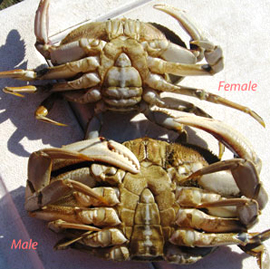
In Canada, legally harvested Dungeness are male and must be a minimum of 165mm wide, measured in a straight line across the widest part of the carapace. Gender is easily ascertained by examining the crab’s abdomen; the female (top) has a broad abdomen, the male (bottom) has a narrow abdomen. The thorax, located directly above the abdomen, is your “kill zone.”
Dungeness can be killed easily and swiftly with a single sharp strike to the under shell; simply place the crab on its back in your kitchen sink and direct a swift blow to the thorax (located directly above the abdomen) using a mallet, small hammer or other blunt instrument. In a pinch, the handle of a chef’s knife will also work, but as the objective here is blunt force, do not use the blade. Merely piercing the thorax will kill the crab, but not instantly, and it will continue to struggle for up to a minute. The blow should be hard enough to break the under shell but not so hard that it breaks the crab in half and cracks the top shell. Unlike lobster, you will know when you have killed a crab because it will actually stop moving and all the legs will relax.
Once you have killed the crab, turn it top shell side up, hold the legs on one side firmly with your non-dominant hand, and use your dominant hand to pry/twist off the top shell. As the shell releases from the body, the crab legs will fall naturally into two parts and most of the viscera will remain inside the shell.

The “body” meat will remain attached to the tops of the legs, encased in a translucent layer of shell. Sometimes the gills will stick to this meat; if this happens, simply peel them off and discard. Rinse the crab halves under running water.
Shake out and discard the innards from the top shells, then give them a good wash under running water. Boil them in a separate pan for 5 minutes, drain and set aside.
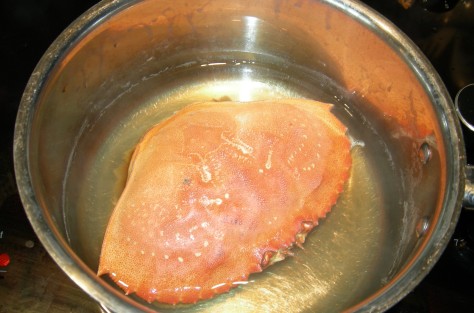
While the top shells are boiling, place the crab halves into your steamer basket over two inches of boiling water and cook for 5 to 7 minutes, depending on the size of your crab.

Remove the crab from the steamer and match up the left with the right side on a plate.

Set the cooked top shell back on top of the crab halves and Voilà! Piping hot, fresh steamed “whole” crab, without the mess or the waste. Serve immediately with garlic butter and champagne!

For the garlic butter, using a small saucepan, squash six garlic cloves to pop them out of their skins, then squash them a few more times to release the oils. Melt 1/4 cup of butter in a glass measuring cup in the microwave, then add the garlic. Allow it to steep for at least ten minutes. Briefly reheat to re-melt the butter, remove the garlic (okay, I admit it, I can’t be bothered to pick it out), and transfer the remaining butter to two small dipping bowls (actually, I can’t be bothered to do this either; presentation be damned, it just makes for extra dishes).
Ingredients
2 live Dungeness crabs, between 1 and 1 1/2 lbs each
1/4 cup butter
6 garlic cloves
Method
1. Being careful not to crack the top shell, kill and clean the crab. Scrub the top shells and boil them in a separate pot for 5 minutes. Drain and set aside.
2. Steam the crab “halves” until the claw shells are bright red and the meat is white and opaque, 5 – 7 minutes, depending on the crab size. If you’re uncertain, use an instant read thermometer to confirm that the crab has reached an internal temperature of 165º F.
3. Remove the crab from the steamer and match up the pairs on two pre-warmed plates. Place the cooked top shells back on top of the re-aligned crab halves and serve immediately with the garlic butter.
Serves 2
© copyright 2013 ingrid baier all rights reserved
yes, those jeans make you look fat… it’s your teacher’s fault
“Everything should be made as simple as possible, but no simpler.”
– Albert Einstein
 While Occam’s Razor is a valuable tool, when we misuse it, we fall into the trap of the reductive fallacy, an explanative approach in which highly complex processes are reduced to their elementary components to such a degree that any sense of cause and effect gets lost in the argument.
While Occam’s Razor is a valuable tool, when we misuse it, we fall into the trap of the reductive fallacy, an explanative approach in which highly complex processes are reduced to their elementary components to such a degree that any sense of cause and effect gets lost in the argument.
To wit: “Fewer than half of Ontario’s elementary schools have a health and physical-education teacher, raising questions about efforts to stem rising obesity rates among schoolchildren.” Globe and Mail, March 18, 2013
Physical exercise, (and by implication, physical education), is absolutely crucial to the maintenance of a healthy body, but it is not a panacea and it does not work in a vacuum. The factors that contribute to the growing obesity crisis in Canada are social, psychological, political, economic, cultural, evolutionary, environmental, and biochemical all at the same time, and trying to address this incredibly complex phenomenon simply by mandating thirty minutes of physical activity a day in schools is over-simplistic to the point of naïveté.
First, consider our obesity epidemic from an evolutionary perspective. Despite the blog wars raging between the “carb” people and the “no-carb” people, a growing body of evidence suggests that human metabolism evolved primarily in the era prior to organized agriculture, and that for the first 190,000 of Homo sapiens’ 200,000 years of genetic evolution, our species subsisted on wild, grass fed meat and fish (and their respective fats), as well as naturally occurring ( not cultivated) fruits, vegetables, and nuts. Not only did 95% of human genetic evolution occur in the era prior to the production of cereals, in addition, the feast-or-famine nature of the hunter/gatherer society created “thrifty” genes wherein the ability to store energy as fat became a desirable genetic trait that was passed to future generations by the process of natural selection. Because wheat and barley gradually appeared in the human diet over the last 10,000 years or so, human beings have been eating grains for 5% of their total existence on the planet, and are therefore genetically better adapted to eat fruits and vegetables as their primary source of carbohydrates. The first impacts of cereal production on human health were seen in the nineteenth century with the advent of the industrial revolution and the invention of high-speed rollers mills, which processed grains to the consistency of talcum powder, effectively removing any fiber from the cereal and significantly speeding up the rate at which the carbohydrate was digested and absorbed.
not cultivated) fruits, vegetables, and nuts. Not only did 95% of human genetic evolution occur in the era prior to the production of cereals, in addition, the feast-or-famine nature of the hunter/gatherer society created “thrifty” genes wherein the ability to store energy as fat became a desirable genetic trait that was passed to future generations by the process of natural selection. Because wheat and barley gradually appeared in the human diet over the last 10,000 years or so, human beings have been eating grains for 5% of their total existence on the planet, and are therefore genetically better adapted to eat fruits and vegetables as their primary source of carbohydrates. The first impacts of cereal production on human health were seen in the nineteenth century with the advent of the industrial revolution and the invention of high-speed rollers mills, which processed grains to the consistency of talcum powder, effectively removing any fiber from the cereal and significantly speeding up the rate at which the carbohydrate was digested and absorbed.

Moreover, “modern wheat is no more real wheat than a chimpanzee is an approximation of a human. While our hairy primate relatives share 99 percent of all genes found in humans, with longer arms, full body hair and lesser capacity to win the jackpot at Jeopardy, I trust you can readily tell the difference that 1 percent makes,” (Davis, 2011, p. x).
But I digress…
Not only has the trend towards mechanization and refinement continued to the present day, its negative impact on human health (hugely exacerbated by the Harvard-led anti-fat campaign of the 1980’s) has resulted in an obesity problem of pandemic proportions. At a general biochemical level, the typical Canadian diet makes, and keeps, us fat because it interrupts the normal regulation of the glucose/insulin cycle. How quickly a carbohydrate is absorbed into the bloodstream is measured by its “glycemic index”, with glucose itself (at a score of 100) determining the relative speed of all other foods. The more refined a carbohydrate, the higher its glycemic score; the higher its glycemic score, the faster it enters the bloodstream; the faster it enters the bloodstream, the faster the pancreas releases insulin (a hormone) in order to drive down glucose levels by escorting excess blood sugar into muscle and liver cells. Constantly eating high glycemic carbohydrate foods leads to chronically elevated insulin levels, which in turn are directly correlated to obesity. Not only does insulin cause blood sugar to drop rapidly, which signals the brain (whose preferred fuel source is glucose) that it’s time to eat (even if you’ve just eaten), but insulin is the hormone responsible for regulating energy storage in the human body.
Perversely, the high levels of insulin that remain in the blood after ingesting a high glycemic carbohydrate load prevent the storage cells in the muscles and liver from re-releasing previously stored glucose back into the bloodstream. While it’s true that the body (especially the brain) does need a steady supply of carbohydrate to function properly, we have all but replaced the genetically preferred seasonal fruits and vegetables in our diets with calorie-dense, high-glycemic, refined carbohydrates that lead directly to insulin resistance, increased hunger and weight gain. For this reason alone, the standard formula of “calories eaten, minus calories burned, equals net weight gain” is over simplified, and we cannot address obesity (childhood or otherwise), simply by increasing the “calories burned” or decreasing the “calories eaten”. What we eat is as important as how much we eat and more important than how much we exercise.
And still, it’s not that simple…
Recent research also suggests that obesity is hormonally correlated to the circadian rhythms that regulate sleep. While increased gaming and Facebook time have both been fingered as an “inactivity” factor as it  relates to weight gain, studies also indicate that our ever-increasing exposure to light (and the negative effect of light pollution on the body’s production of the sleep hormone melatonin) in conjunction with the abnormal sleep patterns generated by our “24/7” lifestyle negatively impact the hunger hormones leptin and ghrelin, both of which are also under circadian control. Especially disturbing, given our propensity for nightlights and digital alarm clocks, is the fact that exposure even to very dim light during sleep has the same effect (although the brighter the light, the greater the weight gain). Indeed, even on its dimmest setting, my newly acquired clock radio glows such a violent shade of green that one might reasonably conclude a UFO had landed in the bedroom, and I have relegated it to the bottom shelf on the bookcase where it casts a smaller “shadow”.
relates to weight gain, studies also indicate that our ever-increasing exposure to light (and the negative effect of light pollution on the body’s production of the sleep hormone melatonin) in conjunction with the abnormal sleep patterns generated by our “24/7” lifestyle negatively impact the hunger hormones leptin and ghrelin, both of which are also under circadian control. Especially disturbing, given our propensity for nightlights and digital alarm clocks, is the fact that exposure even to very dim light during sleep has the same effect (although the brighter the light, the greater the weight gain). Indeed, even on its dimmest setting, my newly acquired clock radio glows such a violent shade of green that one might reasonably conclude a UFO had landed in the bedroom, and I have relegated it to the bottom shelf on the bookcase where it casts a smaller “shadow”.
At an individual biochemical level, weight gain is even more complex, because there are also genetic variations within our population that affect our hormonal responses to carbohydrate intake. A significant percentage (approximately 25%) of the population experience a blunted insulin response to elevated blood glucose, and, as a result, are not genetically predisposed to insulin resistance. By the same token, about 25% of the population is extremely carbohydrate sensitive, and cannot eat refined carbohydrates in any amount without gaining weight. To complicate matters still further, there are other individual hormonal responses unrelated to insulin production that further drive weight gain.
Over the course of human evolution, for example, the brain has developed so that it produces the neuroendocrine transmitter, dopamine, after the successful ingestion of food. Commonly known as the “reward hormone,” dopamine plays a key role in human motivation, and it appears to be a primary player in completing our internal atta-boy reward circuit. Research has indicated, however, that the dopamine receptors in the brains of obese persons are compromised, as compared to the dopamine receptors in those test subjects with a normal BMI, leading to the hypothesis that obese persons feel compelled to overeat in the same way that heroin addicts feel compelled to mainline when their dopamine levels are low. Interestingly, one way that dopamine receptors are up-regulated is through calorie restriction, which may explain why gastric bypass surgery remains the only proven long-term solution for morbid obesity. In obese persons with disrupted dopamine receptor sites, the obesity problem cannot be overcome with physical activity alone.
Switching lenses from the micro to the macro, consider next the influence of politics and economics on rising obesity rates. Crop production and food manufacturing are big business (as is the weight loss industry), and school catering services and vending machine operators are in it for the money, not out of an altruistic concern for our children’s health. The crop production and processing industries that constitu te local and global agribusiness, along with their respective lobby groups, all have a vested (read, monetary) interest in keeping us fat. To paraphrase biochemist Barry Sears (and to use an American example), the “eat less” message is a difficult one for agribusiness to digest: “Today agribusiness produces more than 4,000 calories per day for every American. For Americans to eat less, every sector of agribusiness (except the fruit and vegetable sector) has to make less money.” In light of the millions of dollars that American agribusiness (led by the sugar industry), donates directly to political campaigns and lobby groups, it would take a
te local and global agribusiness, along with their respective lobby groups, all have a vested (read, monetary) interest in keeping us fat. To paraphrase biochemist Barry Sears (and to use an American example), the “eat less” message is a difficult one for agribusiness to digest: “Today agribusiness produces more than 4,000 calories per day for every American. For Americans to eat less, every sector of agribusiness (except the fruit and vegetable sector) has to make less money.” In light of the millions of dollars that American agribusiness (led by the sugar industry), donates directly to political campaigns and lobby groups, it would take a superhero remarkable politician, with the political will of Athena to lobby for meaningful changes to the American food pyramid.
The politicization of our food supply also has huge implications for the way obesity divides along socio-economic fault lines, and unsurprisingly, obesity is far more prevalent in lower income households. Calorie for calorie, eating well is expensive, and refined carbs and sugar are cheaper than lean meats, fruits and vegetables (according the USDA, the cost of fruits and vegetables rose 120% between 1985 and 2003, while the cost of sugar and sweets rose less than 50%). In addition, for the “working poor”, who often struggle to feed their children by working two jobs, the time constraints and transportation issues involved with shopping for bulky food items such as fruits and vegetables make it even more prohibitive. On the other hand, research also indicates that once household incomes top $120,000, obesity rates start to rise again, as people in higher income brackets also spend more time working and less time shopping and cooking.
Other environmental factors also drive eating habits; companies spend billions of dollars luring adults and children alike into eating foods they know are unhealthy, and millions more on products development, manipulating their foodstuffs with salt, sugar, and a host of chemicals to make them more addictive. Given that we make more than two hundred food decisions each day, (mostly on auto-pilot), we are unconsciously influenced by marketing, our immediate environment and the people around us far more than our own hunger.
And I haven’t even touched on the psychological issues that drive emotional eating, or considered time-constrained parents who create a life-long pattern by stifling their babies’ cries with a bottle, whether or not said babies are hungry. Rather, I have very briefly touched upon (and grossly oversimplified) some of the issues that contribute to our growing obesity epidemic, not because I think that physical exercise is unimportant, or because I think it shouldn’t be implemented into our schools, but because in trying to explain an extremely complex set of circumstances by isolating a single “cause,” we have created a reductive fallacy in which public education (now there’s a surprise), takes the fall.
The trend towards lower levels of physical activity is itself a nebulous social phenomenon that is difficult to link to a single cause: increased mechanization; urban sprawl (including the rise of neighbor-unfriendly Monster Houses) that discourages old fashioned “playing outside”; the uptick in parental paranoia generated by increased media coverage of sexual predators; the exponential growth of electronic entertainment, in addition to crunched school budgets that squeeze out gym time, all converge to keep children inside and sedentary, rather than outside and active. Moreover, the absence of a dedicated physical education teacher is not the logical equivalent of “no gym class.”
Adiposity is truly a multi-faceted affair and identifying any given factor as “the” cause of obesity is tantamount to trying to understand a food web by studying a single organism. To make any sense of it, and to have any hope of improving it, we must examine the ecology of human obesity as a whole.
© copyright 2013 ingrid baier all rights reserved
References
Brand-Miller, Jennie et al. (2003). The New Glucose Revolution: The Authoritative Guide to the Glycemic Index. New York, NY: Marlowe and Company.
Bray, M.S. and M.E. Young. (2006). “Circadian rhythms in the development of obesity; potential for the circadian clock with the adipocyte.” Obesity Reviews. Retrieved March 27, 2011 from: http://www.ysonut.fr/pdf/Circadian-rhythms-developpement-obesity.pdf
Capponi, Pat. (1997) Dispatches from the Poverty Line. Middlesex, England: Penguin Books
Davis, William. (2011). Wheat Belly. New York, NY: Rodale Press
Ehrnreich, Barbara. (2001). Nickel and Dimed: On (not) Getting by in America. NY, New York: Henry Holt
Gittleson, Wendy. (2011). “The Politics of Obesity”. The Pragmatic Progressive. Retrieved march 28, 2011 from: http://thepragmaticprogressive.org/wp/2011/02/23/the-politics-of-obesity-2/
Lollie, Summer. (2010). “Crop Production & Basic Processing”. Open Secrets. Retrieved March 29, 2011 from: http://www.opensecrets.org/industries/background.php?cycle=2010&ind=A01
Paarlberg, Robert. Food Politics: What Everyone Needs to Know. Oxford: Oxford University Press.
Payne, Ruby K. (2005). A Framework for Understanding Poverty. Highlands, Texas: aha! Process, Inc
Schlosser, Eric. (2002). Fast Food Nation.New York, NY: Harper Collins.
Sears, Barry. (2005). The Anti-Inflammation Zone: Reversing the Silent Epidemic That’s Destroying Our Health. New York, NY: Harper Collins.
Spurlock, Morgan (Dir). (2004). Supersize Me: A Film of Epic Proportions. (Roadside Attractions).
Wang, Gene-Jack et al. (2001). “Brain dopamine and obesity”. The Lancet. Retrieved March 27, 2011 from: http://www.foodaddictionsummit.org/docs/11Noble.pdf
Wansink, Brian.(2010). Mindless Eating: Why We Eat More Than We Think. New York, NY: Bantam Books.
eye in the sky…
I am the eye in the sky,
Looking at you—
I can read your mind;
I am the maker of rules,
Dealing with fools–
I can cheat you blind.
But I don’t need to see any more to know that
I can read your mind…
– Eric Woolfson, The Alan Parsons Project
catch-22; bridging literacy and literature in the classroom (part 1)
“What Orwell feared were those who would ban books. What Huxley feared was that there would be no reason to ban a book, for there would be no one who wanted to read one…. Orwell feared the truth would be concealed from us. Huxley feared the truth would be drowned in a sea of irrelevance.” – Neil Postman, Amusing Ourselves to Death
Postman published his book in 1985, a year after George Orwell’s temporal setting for his dystopian novel, 1984, but ironically, the culture of surveillance that Orwell so abhorred is a circumstance our post-millennium citizens largely welcome. We have devolved into a celebrity culture in which it is normal, desirable even, to be relentlessly observed, and we tally our social success using tweets and twitters and likes  on Facebook, where we blithely post huge swaths of our lives with nary a concern for personal privacy. It doesn’t occur to us that much of what happens on Facebook is stalking behavior, any more than it occurs to us to worry about highly networked government data banks or corporate computer surveillance. In a culture where a Paparazzi tail is the sincerest form of flattery and renegade civil libertarians are the new social pariahs, we have invited the brazen and unremitting violation of what used to be our constitutional right to privacy.
on Facebook, where we blithely post huge swaths of our lives with nary a concern for personal privacy. It doesn’t occur to us that much of what happens on Facebook is stalking behavior, any more than it occurs to us to worry about highly networked government data banks or corporate computer surveillance. In a culture where a Paparazzi tail is the sincerest form of flattery and renegade civil libertarians are the new social pariahs, we have invited the brazen and unremitting violation of what used to be our constitutional right to privacy.
The implications for pedagogy are profound. As we move deeper into the digital age, trading the printed word for the glittering image, we find ourselves straddling the divide between process and result with regard to literacy development. Studies indicate not only that children learn to read most effectively by reading, but also that they can be most easily enticed towards literacy by reading what they like. This creates a catch-22 for teachers, as research demonstrates that texts that reflect and incorporate popular celebrity culture do not facilitate higher order thinking skills to the same degree as more challenging literary texts, an unintended consequence of which appears to be the systematic loss of the linguistic and intellectual tools needed to separate political truth from illusion. As a result, teachers find themselves in the unenviable position of choosing between literacy and those who choose to function as illiterate.
Notwithstanding the eternal vitriol raging between highbrow scholars and the literary déclassé, the  benefits of non-literary fiction are myriad, for children – like adults – tend to resist what is forced upon them. They crave personal autonomy and control over what they read. Choice in turn is affected by interest, which is itself influenced (though not fully determined) by individual taste, need and background, and – more often than not – involves selections damningly defined as “pop fiction”.
benefits of non-literary fiction are myriad, for children – like adults – tend to resist what is forced upon them. They crave personal autonomy and control over what they read. Choice in turn is affected by interest, which is itself influenced (though not fully determined) by individual taste, need and background, and – more often than not – involves selections damningly defined as “pop fiction”.
(As an aside, the very notion of self-selecting anything from popular culture itself raises intriguing philosophical questions. There is a tendency for students and teachers alike to conclude that when students choose their own reading material, they are in fact expressing individual preference, thereby creating a sense of empowerment by bringing to the classroom literary content that their teachers would rather not legitimize. In many instances, however, children are influenced to choose materials that are imposed upon them by the social and cultural norms that surround them. Indeed, this same social determinism could be attributed to self-selection in music, food, art and clothing:)
Yes. Well. Meandering down the path of inquiry again… sorry about that.
Ultimately, however, the fallout from the pop-fiction/literature debate lands far beyond mere pedagogy. Western democracy cannot, by definition, flourish without a fully literate electorate, and if schools are graduating citizens who are incapable of distinguishing between verbal claims and published facts, then political leaders no longer need to be competent, sincere or honest, but only to appear as such. We tend not to pay attention to a political candidate or government minister based on issues, but rather on popularity and newsworthiness: a federal aide with a money-laundering, ex-hooker in his past is newsworthy; a charismatic foreign president with a glamorous, fashion-forward wife is newsworthy; a local politician who proposes serious regulatory reform regarding cross-country oil pipelines, on the other hand, is boring.
As a culture, we have been hooked by what is easy: theatre, full-size (non-tabloid) newspapers and literature have been relegated to the margins of cultural life, where they are ignored as elitist or intractable because they do not provide effortless entertainment. This popularization of culture as mere amusement leads to social “decay”, writes philosopher Hannah Arendt, “and those who promote it are not the Tin Pan Alley composers, but a special kind of intellectual… whose sole function is to organize, disseminate and change cultural objects in order to persuade the masses that Hamlet can be as entertaining as My Fair Lady, and perhaps as educational as well. There are many great authors of the past who have survived centuries of oblivion and neglect, but it is still an open question whether they will be able to survive an entertaining (emphasis mine) version of what they have to say.”
If school is a microcosm of the larger political perspective, then we pander to our children’s need for entertainment in the classroom at a serious social cost. In a cultural age where reality television reigns supreme, and popularity, thinly disguised as “google-hits”, dictates newsworthiness, it behooves us to re-establish complexity in our classrooms and to re-connect our children with the literate, print-based world of ideas.
copyright © 2013 ingrid baier all rights reserved
what, the [prize turkey] as big as me?
The Grinch hated Christmas! The whole Christmas season!
Now, please don’t ask why. No one quite knows the reason.
It could be his head wasn’t screwed on just right.
It could be, perhaps, that his shoes were too tight.
But I think that the most likely reason of all
May have been that his heart was two sizes too small.
– Dr. Seuss
While the relative size of my heart remains open to debate, unlike the Grinch, I don’t actually hate Christmas. And while I’m not sure I commemorate the anniversary of Christ’s birth as a celebration of my spiritual deliverance from original sin, the occasion remains nonetheless an excellent excuse to roast a goose and uncork a decent bottle of Barolo. What I grow less enamored with each year, however, is the surfeit of stuff that seems to grow more excessive every season.
My anti-social Yuletide behavior has been a joke in my family for years, and those myriad New Years’ Eves when my Dearly Beloved works the nightshift invariably find me wrapped in a makeshift hazmat suit de-cluttering the garage. I usually attribute my solitary way of ringing in the New Year to being an introvert, (auld lang syne? we don’t need no stinkin’ auld lang syne) but as of late, I have been connecting it to the ocean of excess that has usurped Christmas frivolity at our house.
In all fairness, Christmas is not unique in its trend towards consumerism; indeed, the majority of our high-profile Western celebrations are increasingly subject to the lure of PayPal, but Christmas does lead the pack (the stats are, of course, American; Canada can’t retain its economists long enough to do the math).

Fiscal cliff? What fiscal cliff?
- Valentine’s, 2012: $14B
- Easter, 2012: $17B
- Halloween, 2012: $8B
- Christmas, 2012: $90B on gifts alone
My puzzlings began this year with the innocuous wish-list, that not-so-subtle guerilla tactic that serves to undermine Noel surprises (no really… you shouldn’t have), the world over, and after weeks of cajoling and pleading and begging and whining (mine) the kids relented and gave me their lists:
Offspring #1
Milk chocolate
Offspring #2
Soul Calibur V DLC (available February 2013)
Uhmm, thanks for coming out…
Had I proceeded according to the aforementioned wish-list mentality—you know, the one that openly acknowledges the nebulous correlation between Christmas spending and ultimate consumer satisfaction—my contribution to the pile of kid-presents already under the tree would have been 1 box of Bernard Callebaut chocolates and 1 IOU. As fate—cleverly disguised as generosity—would have it, however, our offspring jointly opened no less than 14 unrequested, unanticipated, and—most likely—unwanted gifts from mom, leaving them each with exactly 7 unrequested, unanticipated and—most likely—unwanted new things to store, wear, read, or otherwise make room for in their busy lives.
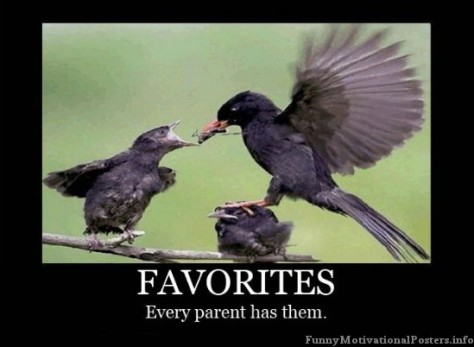
Yes, seven. Each. Count them. Yes, it’s equal. Count them again. Okay, I’m just about done with this conversation…
Christmas in North America is kind of like watching Dickens’ A Christmas Carol through the wrong end of a telescope, for while we want to give with the exuberance of a reformed Scrooge, we have lost the resounding sense of grace that defines Scrooge’s transformation, and our compulsive consumerism has replaced Scrooge’s spontaneous gratitude with an uneasy combination of weary obligation and raging entitlement that undermines the very purpose of the story—to say nothing of Christmas itself.
Scrooge bubbles over with a profound sense of gratitude—for a second chance, for the opportunity to make a difference—and he can’t help but get it right, for the Cratchits want for everything. How many of us are filled with this same sense of joy and excitement as we scour the mall for “last minute stocking stuffers?” (Velvet pajama bowties? Really?)
Unfortunately, our current preoccupation with Bigger, Better, More, and (perhaps most significantly), DISPOSABLE, has us (and the planet) drowning in clutter, and one fall-out from this constant material bombardment is the drowning of our inner sense of direction. For things are never just things, and cumulatively they form a black hole of association, both positive and negative. They speak of wonderful travels and incredible relationships… but they also remind us of obligations we’d rather not honor, whisper of memories we’d rather forget, and admonish us for roads not taken and choices we didn’t have the courage to make.
Yes, the mathematically nonsensical “plus-one” rule has its place, (indeed, 1 bad guy=2 bad guys, and 1 weapon=2 weapons is foundational to police officer survival and 1 deer=12 deer is apt to keep your vehicle out of the ditch), but how did one specific mainstay of the Seven Tactical Principles morph into a general consumer philosophy so that 1 present=2 presents? How did we ever end up concluding that if one is good, then two must be better?
And how did I, the original “less is more” girl, get caught up in this cycle of buying stuff for my kids that they neither need nor appreciate?
I’m not sure… I’ve puzzled and puzzled and my puzzler is sore… in the meantime, I have a garage to de-clutter.
don’t be the lid…
“There is no doubt that creativity is the most important human resource of all. Without creativity, there would be no progress, and we would be forever repeating the same patterns.” — Edward de Bono
dulce et decorum est pro patria mori
Here I stand, I can do no other.
– Martin Luther
If you were a nation, would you be at war?
This question downloaded itself—seemingly at random—into my consciousness during a particularly turbulent era in my own life, creating a “eureka” moment that directed me—one baby step at a time—towards a discovery of peace.
I’m still working on it.
During this week of Remembrance Day preparations, I have been considering our assumptions about the way we model peace in the classroom, and I have concluded that Remembrance Day should be more than the theme of the week, more than a poppy project in art, or Dona Nobis Pacem in music. I would never wish to undermine the purpose of Remembrance Day, or its focus on our veterans, but I tend to shy away from the lone perspective and I can’t help wondering whether an approach that engages students at a more sophisticated intellectual level—one that more closely matches the complexity of war itself—might be more useful in preventing war in the first place…
Consider, if you will, the Vietnam War.
Yes, I hear you,
… we’re Canadian, that war doesn’t concern us on Remembrance Day, that was an American crusade…
but that assumption actually serves to highlight the very ways in which human collectives memorialize military conflict. What most westerners actually mean by “The Vietnam War” would be more accurately described as “The American War in Vietnam,” given that the geographical collective currently identified as Vietnam had essentially been at war since the French colonization of the Indochina Peninsula in the mid-19th century, (a state of affairs complicated during the Second World War when the Japanese interned the French), and by the time Lyndon B. Johnson escalated American involvement in the region in 1963, Vietnam had been the subject of external military domination for more than a century. U.S. troops pulled out of the region in 1975 only to be replaced by invading Chinese forces in 1979, and yet western perception continues to define “The Vietnam War” as the era of American involvement between 1963 and 1975.
What’s wrong with this picture?
Consider as well this particular conflict in light of the purpose of Remembrance Day itself: the nature of the “Vietnam War” sparked an unprecedented reception for American soldiers returning home and it was the first (American) full-scale war in which the perception of soldier as hero was challenged, and personal bitterness became the defining characteristic of a war largely regarded as “meaningless.”
Divorcing our veterans from the conflicts in which they served, as per sanitized public education Remembrance Day services, is as disingenuous as it is ineffective. The truth is, we can’t ethically or logically separate military business from the people who conduct it, and an examination of the effect of political conflict upon thousands of drafted soldiers may give students a more meaningful perspective regarding the social and psychological realities of serving in a warzone than making papier-mâché poppies.
I want to engage our students in a deeper discussion of these concepts that doesn’t reduce the sacrifice of millions of soldiers to a Friday afternoon art project. I want our kids to actually think about their own peace-time assumptions without trivializing the individuals who comprise the military.
But I also want them to consider the words of John McCrae in light of the conclusions of Wilfred Owen, who died a week before the signing of the Armistice on November 11th, and whose poetry has never been read at any Remembrance Day ceremony I have ever attended.
The question becomes, then, can we direct our students on this kind of inquiry without undermining the very security that the social studies curriculum seeks to promote?
© copyright 2012 ingrid baier all rights reserved
Dulce et Decorum Est
Bent double, like old beggars under sacks,
Knock-kneed, coughing like hags, we cursed through sludge,
Till on the haunting flares we turned our backs
And towards our distant rest began to trudge.
Men marched asleep. Many had lost their boots,
But limped on, blood-shod. All went lame; all blind;
Drunk with fatigue; deaf even to the hoots
Of tired, outstripped Five-Nines that dropped behind.
Gas! GAS! Quick, boys! – An ecstasy of fumbling,
Fitting the clumsy helmets just in time;
But someone still was yelling out and stumbling
And flound’ring like a man in fire or lime . . .
Dim through the misty panes and thick green light,
As under a green sea, I saw him drowning.
In all my dreams before my helpless sight,
He plunges at me, guttering, choking, drowning.
If in some smothering dreams, you too could pace
Behind the wagon that we flung him in,
And watch the white eyes writhing in his face,
His hanging face, like a devil’s sick of sin;
If you could hear, at every jolt, the blood
Come gargling from the froth-corrupted lungs,
Obscene as cancer, bitter as the cud
Of vile, incurable sores on innocent tongues, –
My friend, you would not tell with such high zest
To children ardent for some desperate glory,
The old Lie: Dulce et decorum est
Pro patria mori.
Wilfred Owen (1893-1918)



